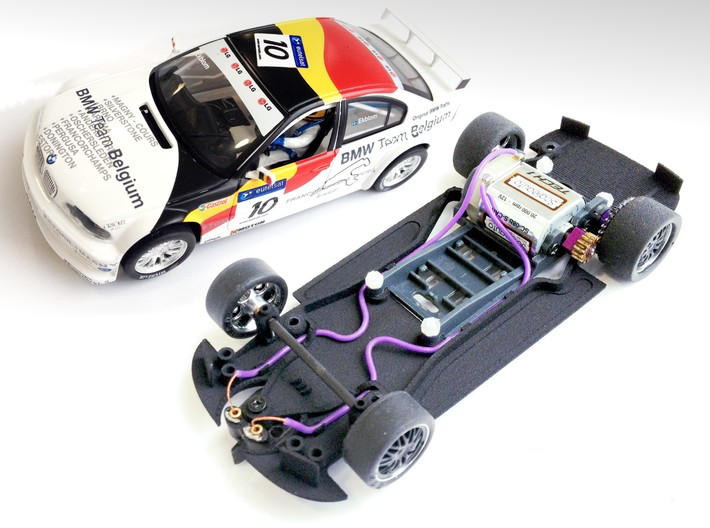With the introduction of 3D printing, the slot car tuner has been gifted with options for improving his current cars and for re-vamping his old and/or damaged cars. Almost weekly, new 3D chassis are announced for cars that previously did not have this option. In fact, many of the 3D chassis designers will design and build a chassis for almost any car if you ask them.
Most (but not all) 3D chassis are designed to utilize Slot.It components, starting with the motor pod. Slot.It motor pods have specific dimensions, key ones being the four mounting points to the chassis. Compatible 3D chassis are designed to match these four points. There are even 3D printed Slot.It-compatible motor pods available, some with adjustable rear axle ride heights.
Here's an example of a completely set-up 3D-printed chassis using a Slot.It sidewinder motor pod. All that's needed for digital racing is to add a chip:

So, what are the pros and cons with switching a car from its standard chassis to a 3D one?
Pros:
- Just as similar cars from a specific manufacturer can race competitively amongst themselves by virtue of having similar chassis and motor setups, allowing 3D chassis using Slot.It motor pods can bring cars from different manufacturers closer together in performance. A good example are Slot.It's Group C cars (our Slot.It class) where different car bodies race competitively because of very similar chassis and identical mechanical parts.
- Mounting mechanical components to the 3D chassis is very easy.
- Mounting the chassis to the body is also extremely easy since specific chassis are made for specific cars.
- The nature of 3D chassis design mandates the use of high-quality mechanical parts including, guide flags, axles, wheels and gears. These may be from any manufacturer and even some of the original car's components such as front axle, front wheels and front tyres may be used. I even have one car where I've used both front and rear wheels from the original.
- Very smooth and good performance as a result of these components working with the chassis.
- Ability to change and/or replace components very easily.
- You can usually have a choice of colour for the chassis. This can be for matching the car's paint job or personal preference. For example a black chassis can be used to make the car's underside look more realistic or hidden (shadowed) where it shows in a side, front or rear view. Alternatively, a lighter colour can be useful in highlighting items attached to the chassis such as screws.
- Cost and availability of the chassis.
- Cost and availability of the motor pod.
- Cost and availability of the ancillary parts mentioned above - guide flags, axles, wheels and gears.
- Having to put together an interior comprising at least a flat shelf with driver head and arms.
Typically, to put together a chassis once you've acquired it, you'll need some M2 set/grub screws of a couple lenghts for locating the front axle and adjusting its height. If you go for an adjustable motor pod, you'll need them there too. I like to have a selection of lengths but 6mm and 8mm is a good start. The front axle requires four and if you go for an adjustable 3D motor pod, you'll need four there too. The motor pod will also require Slot.It spherical bushings. Of course you'll also need a guide flag, axles, wheels, gears and tyres. These are all available at the online shops listed above.
For information on 3D printed chassis and components, check out this post of mine from January 2017: viewtopic.php?f=7&t=1119
Lastly but very importantly, be sure that the class you're preparing the car for allows 3D chassis. You can see the FRC class rules here: viewforum.php?f=17
So, do you see any other pros or cons? Let’s hear your thoughts in the comments below.